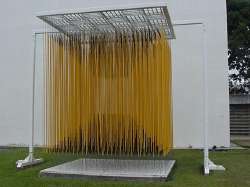
The idea of introducing movement into painting is as old as art itself. Perhaps it is more obvious in certain work, such as those of Michelangelo or other artists, in whom the desire to project figures into space, to create the illusion that they can move in all directions, becomes almost an obsession. In a more conceptual way, it is in Cezanne and the Cubists that one can see appear this dynamic « fourth dimension », which was eventually to take shape in isolated cases, such as Gabo's and Duchamp's machines or Calder's « mobiles ».
I think, however, that it is thanks to our generation that it has come to be understood world-wide that transformable art and the participation of the beholder are here to stay. When I speak of our generation, I mean all the artists whose approach has been marked, from the outset, by the revolutionary shock of the discoveries of modern science concerning the instability of matte rand the ambiguous nature of space, as well as relying on the notion of pure structure. This notion, developed by many different ways and means, has led to the true introduction of movement into the work of art, in what is usually called nowadays « kinetic art ». I must add that we have never amongst ourselves spoken of « kineticism », but always of « kinetic art », as we have never considered the individual development of our researches as an « ism », nor as a school or movement.
http://www.jr-soto.com/fset_intro.html
http://www.jr-soto.com/fset_sonoeuvre_uk.html
Jesus Rafael Soto was born in Ciudad Bolivar, Venezuela in 1923. Soto moved to Paris in the early fifties after receiving a government grant. He lived there until his death in 2005. He was a leader in the kinetic art movement working closely with Carlos Cruz-Diez, Yaacov Agam, Victor Vasarely, Alejandro Otero and others. His work are in numerous collections around the world.
http://www.artnexus.com/ANnewsdetail/15193

in 1970, an exhibition was organized of the French-Venezuelan artist Jesus Rafael Soto (1923). This work was purchased on the occasion, among other things. The "Orange Extension" is a typical example of Soto's works. By including the observer and his/her haptic/kinetic sensations, the physically static matter is united with the changeable spatial and temporal elements.
http://www.mdc.hr/msu/en/djela/2-3-4djela.html

The recent Jesús Soto retrospective at the Galerie Nationale du Jeu de Paume in Paris should initiate a reconsideration of kinetic art's emotional and existential range.
http://www.sculpture.org/documents/scmag97/soto/sm-soto.shtml

This exhibition at GAMeC – Galleria d’Arte Moderna e Contemporanea di Bergamo presents over fifty works by the Venezuelan artist Jesús Rafael Soto (1923 – 2005), one of the pioneers and great exponents of Kinetic Art. Organised by the Museo Tamayo Arte Contemporáneo in Mexico City, this exhibition comes to Italy after being shown in Mexico and at Fundación Proa in Buenos Aires. The show was originally conceived as a selection of 27 representative works of the artist’s aesthetic investigations from the 1950s until the late 1990s, and has now been increased with a group of significant works as a result of GAMeC’s spatial characteristics.
http://www.e-flux.com/displayshow.php?file=message_1160144645.txt
Jesús Rafael Soto exhibit at Gamec in Bergamo with a virtual sphere composed of the colored strings suspended within a cube.
http://www.youtube.com/watch?v=qJ4dFYIT3s4

Video movimiento (MPG 80K)
Video Penetrable (MPG 120K)
In Ciudad Bolivar between the historic and the new city is the Jesus Soto Modern Art Museum. It is the concretion of Soto's dream to promote and increase the interest for art in his homeland. Thus, his native city was chosen to host a museum of which New York or Paris would be highly proud of.
http://www.venezuelatuya.com/guayana/sotoeng.htm
No comments:
Post a Comment